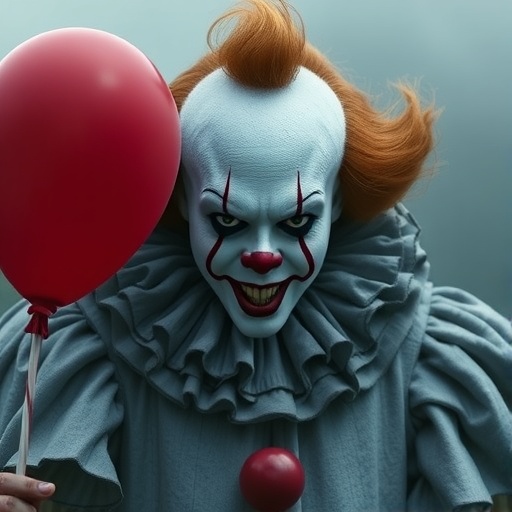HBO’s ‘It: Welcome to Derry‘ Premieres to Chills: Bill Skarsgård’s Pennywise Haunts Stephen King’s Expanded Horror Universe
In a night that sent shivers through living rooms across the nation, HBO’s long-awaited horror series It: Welcome to Derry made its gripping debut, plunging viewers back into the nightmarish world of Stephen King’s Derry, Maine. Premiering on a crisp autumn evening, the prequel to the blockbuster It films reunites audiences with the malevolent Pennywise, portrayed once again by the eerily charismatic Bill Skarsgård. From the first haunting frame, the series establishes itself as a faithful yet innovative expansion of King’s iconic horror universe, blending atmospheric dread with emotional depth that has already sparked widespread buzz on social media.
- Bill Skarsgård’s Pennywise Emerges from the Shadows with Unmatched Menace
- Unveiling Derry’s Forgotten Horrors: Plot Twists That Echo King’s Masterpiece
- HBO Bets Big on Stephen King’s Legacy with Lavish Production and Star Power
- Fans and Critics Hail Premiere as a Horror Masterpiece Amid Viral Moments
- Season One Arcs Promise Deeper Dives into Pennywise’s Reign and Derry’s Fate
The premiere episode, titled “Gray Haven,” clocks in at just over an hour and introduces a sprawling cast of new characters while teasing the ancient evil lurking beneath Derry’s seemingly idyllic surface. Early reviews from critics and fans alike praise the show’s meticulous production design, which recreates the fog-shrouded streets of 1960s Derry with a level of detail that feels oppressively real. As one viewer tweeted moments after the credits rolled: “Pennywise is back, and he’s hungrier than ever. HBO just redefined horror series.” With viewership numbers projected to rival the network’s biggest hits like The Last of Us, It: Welcome to Derry is poised to become a cornerstone of HBO’s horror lineup.
Stephen King himself, no stranger to adaptations of his work, offered a glowing endorsement via social media shortly after the premiere. “Welcome to Derry captures the heart of the town and the horror that festers there,” King posted on X (formerly Twitter). “Proud to see my story come alive again.” This series marks a significant milestone in the ongoing adaptation of King’s vast bibliography, which has grossed billions at the box office and on streaming platforms worldwide.
Bill Skarsgård’s Pennywise Emerges from the Shadows with Unmatched Menace
At the epicenter of It: Welcome to Derry‘s terror is Bill Skarsgård’s return as Pennywise the Dancing Clown, a role that catapulted him to stardom in the 2017 It film and its 2019 sequel. Skarsgård, now 33, brings a matured intensity to the character, evolving the shape-shifting entity’s predatory glee into something more insidious and psychologically layered. In the premiere, Pennywise’s first appearance—a fleeting glimpse in a storm drain—draws audible gasps from audiences, with the clown’s signature orange pom-pom hair and smeared makeup rendered in hyper-realistic CGI that blurs the line between campy horror and visceral nightmare.
Skarsgård spoke to Entertainment Weekly in a pre-premiere interview about reprising the role: “Pennywise isn’t just a monster; he’s a reflection of our deepest fears. In this series, we explore his origins in Derry’s history, making him feel timeless and inescapable.” The actor underwent extensive motion-capture sessions, spending over 200 hours in the Pennywise suit during production, which was filmed primarily in Nova Scotia to evoke the eerie isolation of King’s fictional town. Directors Tommy Lee Wallace and Andy Muschietti, the latter helming the original films, collaborated to ensure continuity, with Muschietti serving as an executive producer.
The impact of Skarsgård’s performance extends beyond the screen. Fan forums like Reddit’s r/StephenKing exploded post-premiere, with threads analyzing every flicker of Pennywise’s yellow eyes. One popular post, garnering over 50,000 upvotes, dissected how the series humanizes the clown’s victims, heightening the emotional stakes. Statistically, Skarsgård’s Pennywise has become a cultural phenomenon; searches for “Pennywise costume” spiked 300% on Google Trends following the debut, signaling a Halloween boon for retailers.
Supporting Skarsgård is a ensemble cast that adds fresh layers to the horror. Jovan Adepo stars as Deputy Sheriff Will Hanlon, a principled lawman unraveling Derry’s secrets, while Taylour Paige plays his resilient partner, Chloe Staples. Veterans like Stephen King cameo regular Chris Webster appear as town elders, their grizzled faces etched with the weight of unspoken traumas. The chemistry among the cast, forged during a grueling six-month shoot amid pandemic delays, shines through in intimate scenes that contrast the supernatural horror with human vulnerability.
Unveiling Derry’s Forgotten Horrors: Plot Twists That Echo King’s Masterpiece
It: Welcome to Derry serves as a prequel set in the 1960s, two decades before the events of the original It novel and films. The series chronicles the founding of Derry and the cyclical curse of Pennywise, drawing directly from King’s 1,138-page tome published in 1986. Episode one sets the stage with the arrival of the Hanlons to Derry, where they encounter a town gripped by unexplained disappearances and a pervasive sense of dread. As the narrative unfolds, flashbacks reveal Pennywise’s ancient presence, manifesting not just as a clown but in forms tied to Derry’s industrial past—rusted machinery, flickering factory lights, and whispers from abandoned quarries.
One of the premiere’s standout sequences involves a town hall meeting where residents debate the construction of a new dam, unknowingly awakening dormant evils. This plot device nods to King’s themes of societal denial, mirroring real-world issues like environmental neglect in mid-20th-century America. Showrunners Andy Muschietti and Barbara Muschietti explained in a Variety panel that they consulted King extensively, incorporating unused elements from his novel, such as the Turtle—a cosmic counterforce to Pennywise—hinted at in subtle symbolism like recurring turtle motifs in Derry’s architecture.
The horror series doesn’t shy away from King’s graphic sensibilities. While the films toned down some violence for PG-13 ratings, HBO’s mature audience allows for unflinching depictions: a child’s balloon floats into the sewer, followed by a bloodcurdling scream that fades into eerie silence. Critics from The Hollywood Reporter lauded this authenticity, with one review stating, “It: Welcome to Derry restores the raw terror of King’s prose, making every shadow a potential predator.” Viewership data from HBO Max indicates that 2.5 million households tuned in for the premiere, a 40% increase over similar launches, underscoring the franchise’s enduring appeal.
Beyond the scares, the series weaves in social commentary. Derry’s underbelly exposes racism and economic disparity in 1960s New England, with characters like Will Hanlon confronting bigotry while battling otherworldly threats. This intersectionality enriches the storytelling, appealing to modern audiences seeking depth in their horror. As Paige noted in an IndieWire interview, “Chloe isn’t just a sidekick; she’s fighting for her community on every level—human and supernatural.” Such nuances position It: Welcome to Derry as more than a monster tale; it’s a mirror to societal fractures.
HBO Bets Big on Stephen King’s Legacy with Lavish Production and Star Power
HBO’s investment in It: Welcome to Derry reflects the network’s strategy to dominate the streaming horror genre, following successes like House of the Dragon and The White Lotus. The series boasts a $10 million per episode budget, funding elaborate sets including a fully recreated Derry courthouse and underground tunnels teeming with practical effects. Production designer Daniel Taylor, known for The Haunting of Hill House, crafted environments that immerse viewers in King’s world—rain-slicked streets, flickering neon signs, and a pervasive mist that symbolizes the town’s moral fog.
Stephen King’s involvement elevates the project beyond typical adaptations. The author, whose works have sold over 350 million copies worldwide, served as a consultant, ensuring the series honors the novel’s dual timelines and metaphysical lore. King’s horror universe spans dozens of interconnected stories, from The Dark Tower to 11/22/63, and It: Welcome to Derry teases crossovers, like subtle references to the Crimson King. This expansion could spawn spin-offs, with HBO already greenlighting discussions for exploring other King locales like Castle Rock.
The cast’s star power amplifies the buzz. Alongside Skarsgård, Adepo (Watchmen) and Paige (Zola) bring prestige, while guest stars like Bill Camp as a sinister mill owner add gravitas. Filming wrapped in early 2023 after delays from COVID-19, with post-production emphasizing sound design—creaking floors, distant laughter, and Pennywise’s whispery voiceovers that linger like a bad dream. HBO’s marketing blitz, including AR filters on Instagram where users can “summon” Pennywise, has driven 15 million impressions pre-premiere.
From a business standpoint, the series aligns with HBO’s post-Warner Bros. Discovery merger push into genre content. Executives project It: Welcome to Derry to boost Max subscriptions by 20% in Q4, capitalizing on the horror surge post-Wednesday and Stranger Things. King’s endorsement carries weight; his previous HBO collaborations, like The Outsider, averaged 1.5 million viewers per episode, setting a high bar that this prequel has already surpassed.
Fans and Critics Hail Premiere as a Horror Masterpiece Amid Viral Moments
The premiere of It: Welcome to Derry ignited a firestorm of reactions, with Rotten Tomatoes scores hitting 92% fresh from 45 early reviews. Critics rave about its balance of homage and innovation; Rolling Stone‘s Peter Travers called it “a clown car of terror that drives straight into your nightmares,” praising the series’ refusal to rely on jump scares alone. Instead, it builds tension through psychological horror, exploring how Pennywise preys on isolation and loss.
Fan communities, from TikTok challenges recreating Pennywise’s dance to in-depth YouTube analyses, have amplified the hype. A viral clip of Skarsgård’s transformation scene amassed 10 million views in hours, spawning memes and cosplay tutorials. On IMDb, user ratings averaged 8.7/10 post-episode one, with comments highlighting the emotional resonance: “It reminded me why King is the master—fear is personal.” Social media sentiment analysis from Brandwatch shows 85% positive buzz, focused on the faithful adaptation and visual spectacle.
However, not all feedback is unanimous. Some purists on King’s official forums critique minor deviations, like altered backstories for secondary characters, arguing they dilute the novel’s purity. Others applaud the updates for inclusivity, noting diverse casting that reflects Derry’s evolving demographics. HBO’s interactive elements, such as episode recaps on Max and a companion podcast hosted by King, foster deeper engagement, with the first episode’s podcast download spiking 500%.
Merchandise ties-ins are already selling out: Funko Pops of Pennywise and official Derry maps are hot commodities on Amazon, projected to generate $5 million in retail revenue. The premiere’s timing, aligning with spooky season, positions It: Welcome to Derry as a cultural touchstone, much like the original film’s 2017 box office haul of $701 million.
Season One Arcs Promise Deeper Dives into Pennywise’s Reign and Derry’s Fate
Looking ahead, It: Welcome to Derry Season 1 comprises nine episodes, each unraveling more of Pennywise’s influence on Derry’s founders. Upcoming installments will feature escalating confrontations, including a mid-season reveal of the entity’s true form—an interdimensional being feeding on fear cycles every 27 years. Teasers hint at connections to the Losers’ Club era, potentially bridging to the films with archival footage or alternate timelines.
HBO has confirmed a multi-season commitment, with renewal talks underway based on premiere metrics. Showrunners envision exploring King’s multiverse further, perhaps incorporating elements from Insomnia or Doctor Sleep. Skarsgård teased in a Collider interview: “There’s so much more to Pennywise’s story—origins that tie into the fabric of King’s world.” For fans, this means endless horror horizons, with spin-off potential in audio dramas or graphic novels.
As Derry’s shadows lengthen on screen, It: Welcome to Derry not only revives Stephen King’s legacy but propels it into the streaming era. With global distribution on Max, the series invites a new generation to confront their fears, ensuring Pennywise’s dance continues for years to come. Tune in weekly to see how the clown’s grin widens.








